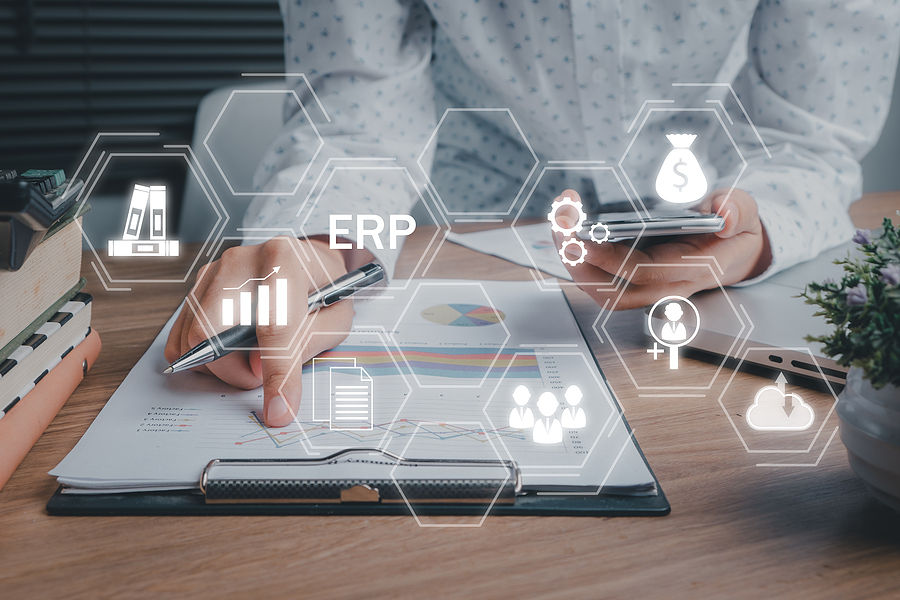No matter which business decisions you make, cost is always a factor. This is true when purchasing supplies and it’s true when choosing your ERP solution. However, ERP pricing is about more than just the total cost. Here are three factors to consider when looking at ERP pricing that will help you choose the best ERP solution for your organization.
ERP Price Research
Multiple, disconnected systems can be replaced with the right ERP solution. An ERP system integrates all aspects of a business, typically including accounting, financial, CRM, supply chain, inventory, and manufacturing applications, and more. With a single-system solution, data is collected, stored, and synchronized, so that it is accessible in real time by all members of an organization. Streamlining business processes, promoting data-rich strategies, and increasing efficiency are other benefits.
According to research on 1,338 ERP projects, Software Path found that the average budget per user is $8,265. This price may or may not be accurate for your business, but it gives you an idea of what to expect as you prepare an ERP budget.
1. Setting Up Your ERP Budget
The first factor to keep in mind is your budget. ERP budgets should consider several factors, most of which are common to all systems.
Here are some questions to ask yourself as you set up your ERP budget:
- What are the options for licensing?
- What is the expected number of users? (Note: Not all systems charge per user.)
- What is the number of companies and locations that will be connected to the ERP system?
- What is the complexity of your business processes?
- How will employees be trained to use the system?
- What is your industry?
- Will you need customization?
- What are your data conversion/migration requirements?
- Do you have a projected consumption volume?
- What is the complexity of third-party applications and how many do you need?
- What is the frequency of ERP vendor updates and upgrades?
Generally speaking, ERP implementation services will cost 1.5 to 2.5 times the base cost of the software.
2. Choosing A Licensing Model
Secondly, decide on a licensing model. One of the biggest expenses for your organization will be licensing. Generally, there are two kinds of licenses: perpetual and subscription.
In perpetual licensing, also called private cloud licensing, a one-time fee is charged for the ERP system. Private or self-managed solutions are best suited to this model. Their responsibility is to purchase hardware and software upfront and to manage security, maintenance, and upgrades. This requires that they have expert IT staff, which is another expense, as well as maintenance fees that are charged for upgrades each year.
Businesses that opt for cloud ERP software usually subscribe to SaaS (Software as a Service). Businesses subscribe to this monthly or annual package to access this software, which is hosted and maintained on a third-party server by the ERP vendor. Software upgrades are also included in SaaS subscriptions. By choosing this licensing model, the IT department can concentrate more on other projects, or they may not be needed at all.
Both licensing options have their advantages and disadvantages.
Consider these questions:
- Is it more important to you that the hardware is in your building, managed by your IT department, or would it be better to eliminate those costs?
- Are there tax advantages to capital rather than operating expenditures?
- Do you have the ability to pay a one-time, large upfront fee, or does ongoing, monthly payment make more sense for your company?
- How much does the total cost of ownership over the product’s lifespan work out to be for your company?
3. Leadership and Organizational Support
Finally, even with your budget and licensing model figured out, you may still have trouble getting everyone onboard with the ERP solution you have chosen. The first and most important step for an ERP investment is getting leadership support. The next is getting organizational support.
Convincing your team members to adopt the new system is important because if employees do not adopt it or do so only half-heartedly, your business will not reap the benefits brought by automating business management processes. ERP implementation and training can disrupt employees’ daily activities, so it is important to address any concerns as soon as possible.
You can get the best support from your team by discussing your plans to implement an ERP system and explaining the benefits. Be sure to address any concerns they may have. Make sure they know you have leadership support and emphasize that your ERP implementation will only succeed with an entire team supporting it.
How ASI Can Help
It’s time to apply your knowledge of ERP price research to a specific cloud ERP solution now that you have a clear sense of costs and factors to consider.
ASI can help you choose the ERP solution that is right for your organization. Identifying the strategies and software solutions designed to help your business succeed is our goal, and we look forward to assisting you. Let’s identify your best business solution together. We will then create an implementation plan and work with your team on installation.
To learn more about ASI’s cloud ERP software and pricing, contact our experts today.

